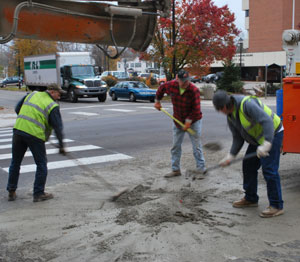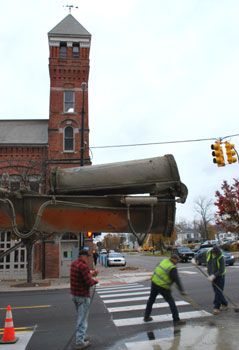When Concrete and Water Don’t Mix

"Butter," in a red shirt, is the driver of the cement mixer truck that spilled a bit of its load. He's assisted in his cleanup effort by two workers who were radioed to come lend a hand.
When Amy Whitesall filed a Stopped. Watched. item about a concrete spill downtown, The Chronicle wondered if it would still be there by the time we hoofed it over to Huron and Fifth where the spill had occurred.
Yep, still there, but three guys from Superior Materials were attacking the pile of wet cement in the pedestrian walkway with shovels and a broom. (Superior Materials of Farmington Hills bought out Killins Concrete on the west side of Ann Arbor at Liberty and Wagoner about a year ago, but the three-man crew work out of the old Killins location).
It was about an eighth of a cubic yard that spilled, or about two wheelbarrows’ full – not really all that much compared to a spill the driver’s colleagues recalled from the late ’90s that happened one block further down on Huron right next to the Ann Arbor News building. On that occasion a collision with an automobile caused an accidental pour that resulted in a concrete-filled car.

Hosing off of the concrete slurry commenced but was shut down by Mike Bergren from the city. They're working at the corner of Huron & Fifth – the Hands-On Museum is in the background.
Today, less than five minutes after The Chronicle arrived, the pile of concrete in the crosswalk had disappeared into the back of the truck. How did it get out of the mixing drum and onto the pavement in the first place? Did “Butter,” the driver of the mixer, accidentally hit the “pour” button sitting in the cab waiting for the light to change? Nope. “Butter” said that a driver in front of him had suddenly felt the urge to change lanes, and that he had to hit the brakes or else rear-end him. The momentum of the concrete mixture in the drum carried it right out the front chute and onto the pavement. It’s not like this happens all the time – less often that 1 in 100 trips, according to “Butter’s” co-workers – but it’s not unheard of either.
After the solid mass of concrete had been scraped out of the crosswalk with flat-nosed shovels, “Butter” began hosing the remaining slurry into the gutter with the water supply from his truck. Not so fast, said Mike Bergren, assistant field operations manager with the city of Ann Arbor. Bergren happened to be walking by on the way to a meeting. He explained to The Chronicle that “wash out” from hosing the chute isn’t allowed into the storm drains (on pain of a $500 fine), and for the same reason, he didn’t want to see the rest of the spill hosed down. So the spraying with the hose was shut down. Bergren said he didn’t see fit to fine these guys, because they were trying to do the right thing. So how were they supposed to finish their cleanup?
A quick phone call from Bergren summoned a street sweeper from the city. So the concrete mixer and its driver continued on their way to the job site at State and Washington (presumably North Quad, the UM dormitory currently under construction) while two guys stayed behind in their smaller truck to wait for the street sweeper.
Waiting for the sweeper, The Chronicle learned a lot about the science of concrete. For example, there are over 2,000 different mixtures, with set-up times from a few minutes to over 24 hours. And one of the pieces of equipment they use to prepare the mixtures is a boiler for the water. Depending on the mixture, it needs to arrive at the job site at 65-70 degrees, something that gets measured before a load will be accepted for a pour.
About a half hour after Begren called in the sweeper, it arrived on the scene and did its work.




